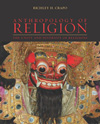
Religious Adaptation and Change |  |
Chapter Summary- Religion functions as a conservative force within society. Its sacred symbols are derived from those characteristics of a society's social organization that need to inspire respect and deference for society to function. By transforming these traits into sacred symbols, religion inspires people to support those customs that insure the stability and continuity of society even if they otherwise would not recognize the importance of doing so.
- Despite its conservative nature, religion does change. One source of change is syncretism, the borrowing of religious traits from other religions.
- Religion is part of the system of culture and, as such, can be seen as playing a role in the human adaptation to the circumstances of survival.
- Especially in societies in which members live in small, face-to-face communities and share a single religious ideology, religion is highly integrated into the daily operation of other institutions such as politics. However, in societies with large populations, religion may become less involved in the day-to-day business and running of other institutions, a process called secularization. Causes of secularization include population growth, which makes it increasingly likely that important transactions will occur among strangers, and increasing technological control of parts of nature that were previously understood only in religious terms.
- Although religion normally emphasizes stability and functions to inhibit social change, there are special circumstances under which religion may play a prominent role in revolutionary social changes. Such religious change often occur in times of social upheaval, producing new religions that offer a new system of religious beliefs and values and the promise of societal reform.
- Religious fundamentalism is (1) an emphasis on religious "fundamentals", the "the rock-solid, hard-binding, time-tested, text based verities that give believers total assurance and total missions", (2) a world-view that portrays its followers as being opposed by powerful or dangerous enemies, both supernatural and human, and (3) political activism aimed at recruiting others to their "fundamentals", fighting back against the enemies the perceive as being opposed to their beliefs and values, and creating a society that is guided by their religious beliefs and values. One circumstance that can make religious fundamentalism more attractive is the personal dissatisfaction that arises from status discrepancy, a perceived discrepancy between a person's expectations of success and his or her actual achievements.
- Nineteenth-century scholars, seeing the steady advance of science from the Enlightenment through the Victorian era, predicted the eventual demise of religion. They envisioned a society guided by a fully rational, scientific philosophy. This anticipation that religion would disappear as society became increasingly secularized seems now naive in having ignored the psychological and social functions that religion can continue to play even in a highly secularized society.
|
|
|